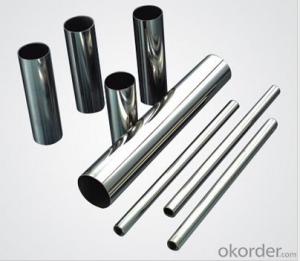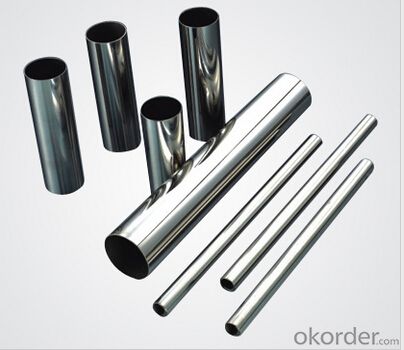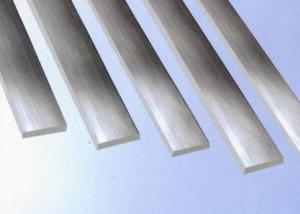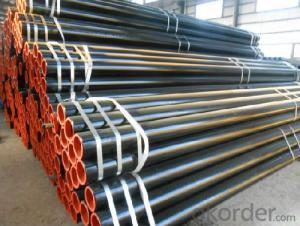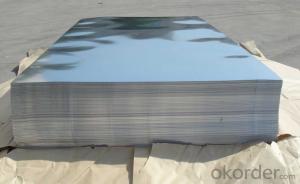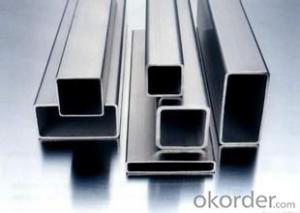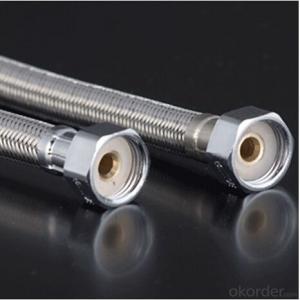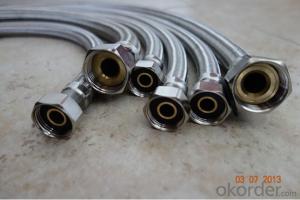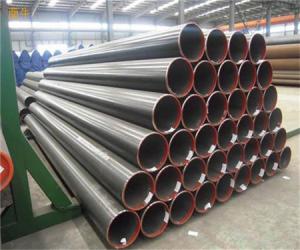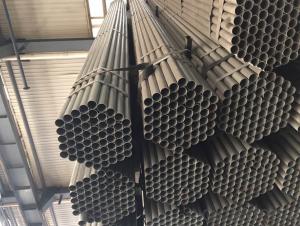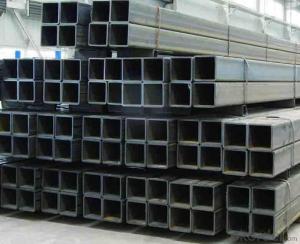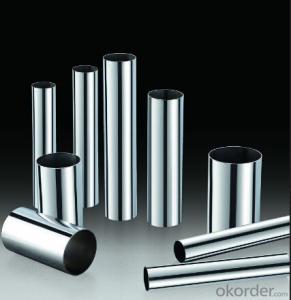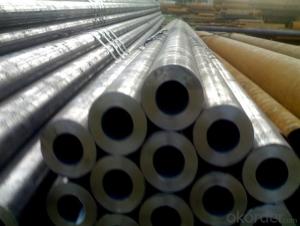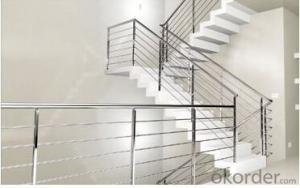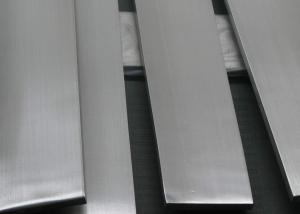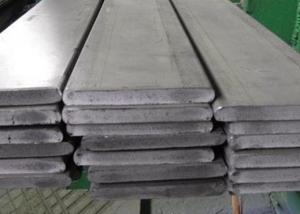Stainless Steel Welded Pipe mechanical Pipe ASTM A554/DIN/EN10296-2/ JIS G3446/GB/T 12770
- Loading Port:
- Ningbo
- Payment Terms:
- TT OR LC
- Min Order Qty:
- 25 m.t.
- Supply Capability:
- 5000 m.t./month
OKorder Service Pledge
OKorder Financial Service
You Might Also Like
1、Structure of Stainless Steel Welded Pipe mechanical Pipe ASTM A554/DIN/EN10296-2/ JIS G3446/GB/T 12770 Description:
Stainless steel welded pipe is actually a cover term, covering a wide range of alloy and making them suitable for different attributes that are used in a very wide and large numbers of different industries. Stainless steel pipe is resistant to erosion, highly flexible, powerful, easy to use, and can be done in distinct approaches, which means that more and more stainless steel was used as a construction material for large-scale, high impact buildings. It can be molded, rolling, and it can create amazing shapes to make it perfect, It is used as experimental buildings. Lightweight traits of hard welded steel pipe makes it perfect for things used in the construction of off shore oil and gas platforms. Crude oil is a corrosive substance and it is positive in the construction of the new drilling platform that uses high alloy, super austenitic welded steel pipe.
2、Main Features of Stainless Steel Welded Pipe mechanical Pipe ASTM A554/DIN/EN10296-2/ JIS G3446/GB/T 12770:
• High manufacturing accuracy
• High strength
• Small inertia resistance
• Strong heat dissipation ability
• Good visual effect
•Reasonable price
3、Stainless Steel Welded Pipe mechanical Pipe ASTM A554/DIN/EN10296-2/ JIS G3446/GB/T 12770 Images:
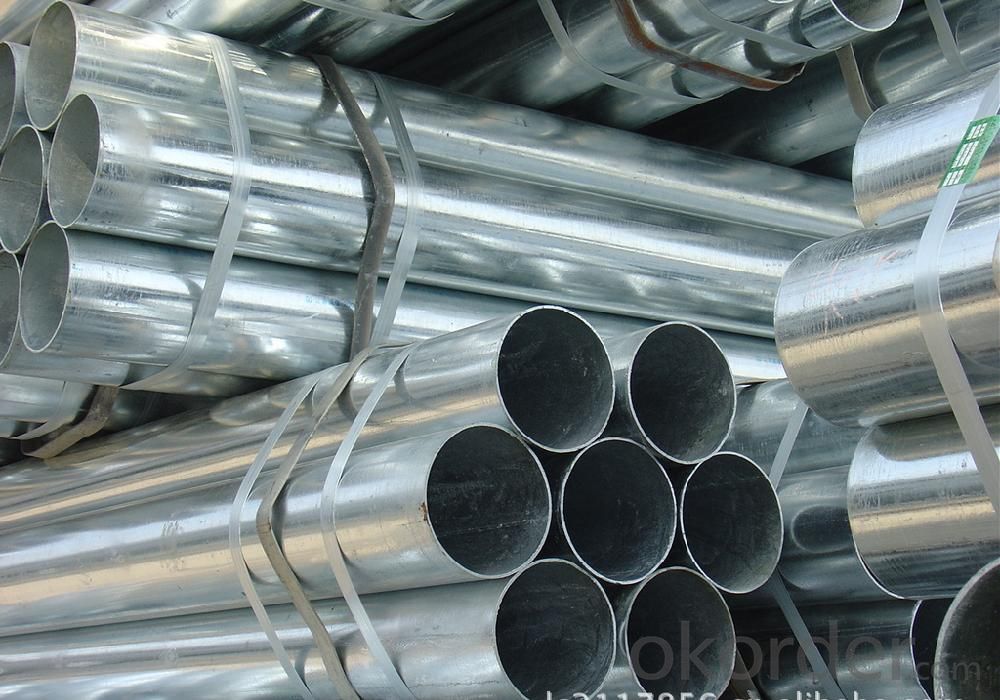
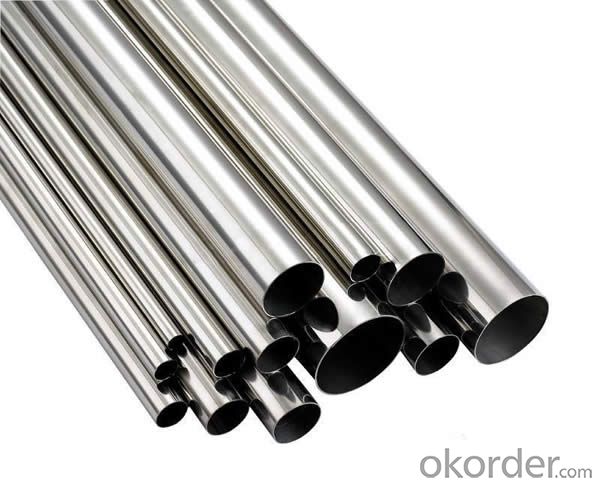
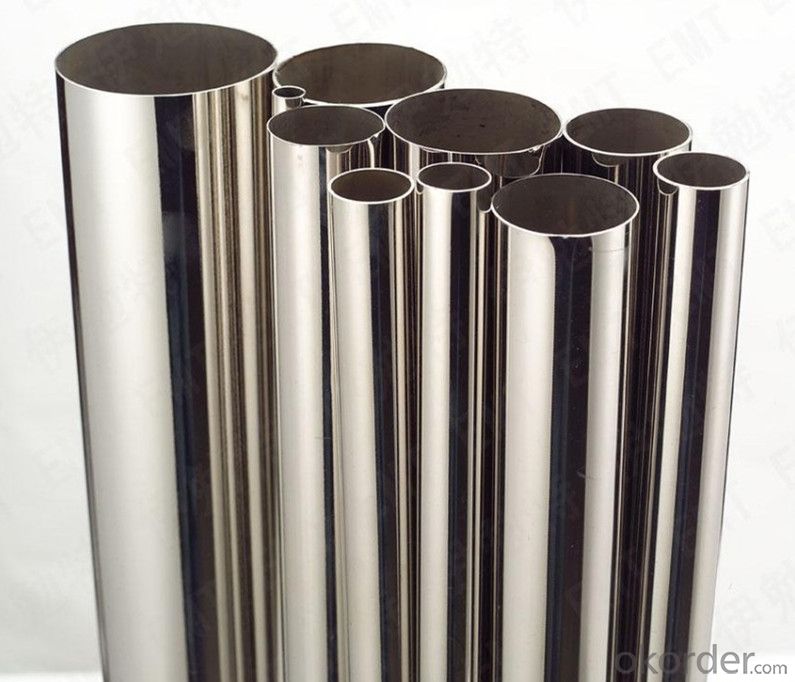
4、Stainless Steel Welded Pipe mechanical Pipe ASTM A554/DIN/EN10296-2/ JIS G3446/GB/T 12770 Specification:
Size:
| OD(mm) | WT(mm) | |||||||||||||
| 0.5 | 0.6 | 0.7 | 0.8 | 0.9 | 1 | 1.2 | 1.5 | 2 | 2.5 | 3 | 4 | 5 | ||
| 9.5 | ||||||||||||||
| 12 | ||||||||||||||
| 1/2' | 12.7 | |||||||||||||
| 13 | ||||||||||||||
| 14 | ||||||||||||||
| 5/8' | 15.9 | |||||||||||||
| 3/8' | 19.1 | |||||||||||||
| 7/8' | 22.2 | |||||||||||||
| 1' | 25.4 | |||||||||||||
| 1-1/8' | 28.6 | |||||||||||||
| 1-1/4' | 31.8 | |||||||||||||
| 1-1/2' | 38.1 | |||||||||||||
| 40 | ||||||||||||||
| 45 | ||||||||||||||
| 2' | 50.8 | |||||||||||||
| 52 | ||||||||||||||
| 2-1/4' | 57.15 | |||||||||||||
| 2-3/8' | 60.3 | |||||||||||||
| 2-1/2' | 63.5 | |||||||||||||
| 70 | ||||||||||||||
| 3' | 76.2 | |||||||||||||
| 85 | ||||||||||||||
| 3-1/2' | 88.9 | |||||||||||||
| 4' | 101.6 | |||||||||||||
| 4-1/8' | 104.78 | |||||||||||||
| 4-1/4' | 107.95 | |||||||||||||
| 4-1/2' | 114.3 | |||||||||||||
| 5-1/4' | 133.35 | |||||||||||||
| 6-1/4' | 158.75 | |||||||||||||
| 8-5/8' | 219.08 | |||||||||||||
Tolerance:
| Standard | OD(mm) | WT(mm) | Tolerance of OD(mm) | Tolerance of WT(mm) | Tolerance of Length(mm) |
| ASTM A554 | ≤12.7 | 0.51~1.24 | ±0.10 | ±10.00%T (±10.00% of nominal wall thickness) | +4.08 -0 |
| >12.7~25.4 | 0.51~1.65 | ±0.13 | |||
| >1.65~3.4 | ±0.25 | ||||
| >25.4~38.1 | 0.64~1.65 | ±0.20 | |||
| >1.65~3.40 | ±0.25 | ||||
| >38.1~50.8 | 0.64~1.24 | ±0.25 | |||
| >1.24~2.11 | ±0.28 | ||||
| >50.8~63.5 | >2.11~3.78 | ±0.30 | |||
| 0.81~1.65 | ±0.30 | ||||
| >1.65~2.77 | ±0.33 | ||||
| >63.5~88.9 | >2.77~4.19 | ±0.36 | |||
| 0.81~4.19 | ±0.36 | ||||
| >88.9~127.0 | 0.89~4.19 | ±0.51 | |||
| >4.19 | ±0.64 | ||||
| >127.0~190.5 | 1.24~6.35 | ±0.64 | |||
| >6.35 | ±0.76 | ||||
| GB/T12770 | <25 | ±0.15 | Clod Rolled ≤0.50 ±0.05 >0.50~1.00 ±0.11 >1.00~2.00 ±0.17 >2.00~3.00 ±7.00%S >3.00 ±10.0%S Hot Rolled ±10.00%S | +20.00 -0 | |
| ≥25~40 | ±0.18 | ||||
| ≥40~50 | ±0.20 | ||||
| ≥50~60 | ±0.23 | ||||
| ≥60~70 | ±0.30 | ||||
| ≥70~80 | ±0.30 | ||||
| ≥80~90 | ±0.30 | ||||
| ≥90~100 | ±0.40 | ||||
| ≥100~200 | ±0.50%D | ||||
| ≥200 | To BeAgreed | ||||
| JIS G3446 | <50 | ±0.25 | <3.00 ±0.30 | +50 -0 | |
| ≥50 | ±0.5% | ≥3.00 ±10.00% |
5、FAQ of Stainless Steel Welded Pipe mechanical Pipe ASTM A554/DIN/EN10296-2/ JIS G3446/GB/T 12770:
①How is the quality of your products?
Our products are manufactured strictly according to national and internaional standard, and we take a test on every pipe before delivered out. If you want see our quality certifications and all kinds of testing report, please just ask us for it.
Guaranteed: If products’ quality don’t accord to discription as we give or the promise before you place order, we promise 100% refund.
②How about price?
Yes, we are factory and be able to give you lowest price below market one, and we have a policy that “ for saving time and absolutely honest business attitude, we quote as lowest as possible for any customer, and discount can be given according to quantity”,if you like bargain and factory price is not low enough as you think, just don’t waste your time.Please trust the quotation we would give you, it is professional one.
③Why should you chose us?
Chose happens because of quality, then price, We can give you both.Additionally, we can also offer professional products inquiry, products knowledge train(for agents), smooth goods delivery, exellent customer solution proposals.Our service formula: good quality+good price+good service=customer’s trust
SGS test is available, customer inspection before shipping is welcome, third party inspection is no problem.
Any question, pls feel free to contact us !
- Q: About stainless steel welding deformation
- For welding of grade 304 stainless steel, the current can be adjusted a little, not preheating, to prevent deformation after welding, the welding sequence should pay attention to, such as left -- right -- in the welding line, avoid welding head, to prevent warping.
- Q: Are stainless steel pipes suitable for pharmaceutical industries?
- Yes, stainless steel pipes are highly suitable for pharmaceutical industries. They offer excellent corrosion resistance, durability, and hygienic properties, making them ideal for transporting and storing pharmaceutical products. Stainless steel pipes are easy to clean, maintain, and sterilize, ensuring the integrity and safety of the pharmaceutical products being handled. Additionally, stainless steel is non-reactive, meaning it does not contaminate or affect the quality of the pharmaceutical substances being transported, making it a reliable choice for the pharmaceutical industry.
- Q: Are stainless steel pipes suitable for fire sprinkler systems?
- Indeed, fire sprinkler systems find stainless steel pipes to be a suitable choice. The durability and longevity of stainless steel, owing to its remarkable resistance to corrosion, make it an ideal material for pipe systems. This corrosion resistance ensures that the pipes will not weaken or deteriorate over time, thus guaranteeing the fire sprinkler system's dependability and effectiveness. Furthermore, stainless steel pipes possess outstanding heat resistance, a crucial attribute in fire protection systems. They can endure high temperatures without warping or melting, thereby ensuring that the pipes will not fail in the event of a fire emergency. All in all, stainless steel pipes offer the requisite strength, durability, and heat resistance needed in fire sprinkler systems, rendering them a suitable choice for such applications.
- Q: Ask experts, 304 stainless steel pipe why rust?
- Stainless steel is not easy to rust and has a lot to do with the composition of stainless steel. In addition to iron, stainless steel contains chromium, nickel, aluminum, silicon and so on. General stainless steel chromium content is generally not less than 12%, high even up to 18%. Steel added elements such as chromium, can change the performance of the steel, such as the molecular structure of steel more uniform on the surface of the steel is more easily to form a layer of dense oxide protective film, thereby greatly improving the ability of corrosion-resistant stainless steel. Therefore, stainless steel can resist fire, water, acid, alkali and various solutions to its corrosion, not rust. The scientists found that the internal structure of the steel is more uniform, various components more closely linked to the corrosion of the more difficult the invasion, also attached to the surface with a layer of oxide film, like iron and steel to wear armor, was not naturally easy to rust.
- Q: What's the difference between stainless steel pipe and stainless steel composite pipe?
- Stainless steel is also divided into several kinds of 200201300301304,The market is generally 301 material, 304 of the best results, followed by 301.
- Q: What is the difference between 304J2 and 316J2 stainless steel pipes?
- The main difference between 304J2 and 316J2 stainless steel pipes lies in their chemical composition and the presence of certain elements. 304J2 stainless steel is a variant of the popular 304 stainless steel grade. It contains around 18-20% chromium and 8-10.5% nickel, which gives it good corrosion resistance, especially in mildly corrosive environments. However, it has a lower molybdenum content compared to 316J2. On the other hand, 316J2 stainless steel is a variant of the 316 stainless steel grade. It contains around 16-18% chromium, 10-14% nickel, and 2-3% molybdenum. The higher molybdenum content enhances its corrosion resistance, making it suitable for more aggressive environments, such as marine or chemical applications. In terms of mechanical properties, both grades have similar tensile strength and yield strength. However, due to the higher nickel and molybdenum content, 316J2 stainless steel pipes generally offer better resistance to pitting and crevice corrosion. Overall, the choice between 304J2 and 316J2 stainless steel pipes depends on the specific application and the level of corrosion resistance required. While 304J2 is suitable for general use in mildly corrosive environments, 316J2 is preferable for applications where exposure to more aggressive conditions is expected.
- Q: Are stainless steel pipes suitable for beer brewing applications?
- Yes, stainless steel pipes are highly suitable for beer brewing applications. Stainless steel is a popular choice in the brewing industry due to its excellent corrosion resistance, durability, and hygiene properties. The smooth surfaces of stainless steel pipes prevent the buildup of bacteria, yeast, and other contaminants, ensuring a clean and safe brewing environment. Stainless steel pipes also have high temperature resistance, which is essential for various brewing processes such as boiling and sterilization. Additionally, stainless steel is an inert material, meaning it does not react with the beer, preserving the taste and quality of the final product. Overall, stainless steel pipes provide the necessary qualities for beer brewing applications and are widely used in the industry.
- Q: Are stainless steel pipes resistant to chloride stress corrosion cracking?
- Yes, stainless steel pipes are generally resistant to chloride stress corrosion cracking due to the high levels of chromium and nickel present in their composition. These elements form a protective oxide layer on the surface of the pipes, preventing the penetration of chlorides and reducing the risk of stress corrosion cracking. However, certain grades of stainless steel may be more susceptible to this type of corrosion in certain environments, so it is important to select the appropriate stainless steel grade for the specific application.
- Q: What are the different end connections available for stainless steel pipes?
- There are several different end connections available for stainless steel pipes, depending on the specific application and requirements. Some of the commonly used end connections include: 1. Threaded Ends: Stainless steel pipes can have threaded ends, which allow them to be easily connected to fittings or other pipes using threaded connections. This type of end connection is commonly used in plumbing and industrial applications. 2. Socket Weld Ends: Socket weld ends are another type of end connection for stainless steel pipes. They involve inserting the pipe into a socket in a fitting and welding it in place. This type of connection provides a strong and leak-proof joint, making it suitable for high-pressure and high-temperature applications. 3. Butt Weld Ends: Butt weld ends involve welding the ends of two stainless steel pipes together. This type of connection is typically used for larger diameter pipes and provides a strong and durable joint. Butt weld ends are commonly used in industries such as oil and gas, chemical processing, and power generation. 4. Flanged Ends: Flanged ends are used when the stainless steel pipe needs to be connected to equipment or components using flanges. Flanges are flat, circular discs with raised edges that allow the pipe to be bolted to the flange. This type of connection is commonly used in industries such as petrochemical, water treatment, and HVAC. 5. Grooved Ends: Grooved ends involve cutting grooves into the ends of stainless steel pipes and using grooved couplings to connect the pipes together. This type of connection is quick and easy to install, making it popular in applications such as fire protection systems and plumbing. It's important to note that the choice of end connection depends on factors such as the pipe size, pressure rating, temperature requirements, and the specific application. Consulting with a professional or referring to industry standards and guidelines can help determine the most suitable end connection for a particular stainless steel pipe.
- Q: Can stainless steel pipes be used in drinking water systems?
- Yes, stainless steel pipes can be used in drinking water systems. Stainless steel is a safe and hygienic material that is resistant to corrosion, making it suitable for carrying drinking water. It does not leach harmful substances into the water and is commonly used in the construction of water supply systems.
Send your message to us
Stainless Steel Welded Pipe mechanical Pipe ASTM A554/DIN/EN10296-2/ JIS G3446/GB/T 12770
- Loading Port:
- Ningbo
- Payment Terms:
- TT OR LC
- Min Order Qty:
- 25 m.t.
- Supply Capability:
- 5000 m.t./month
OKorder Service Pledge
OKorder Financial Service
Similar products
Hot products
Hot Searches
Related keywords
